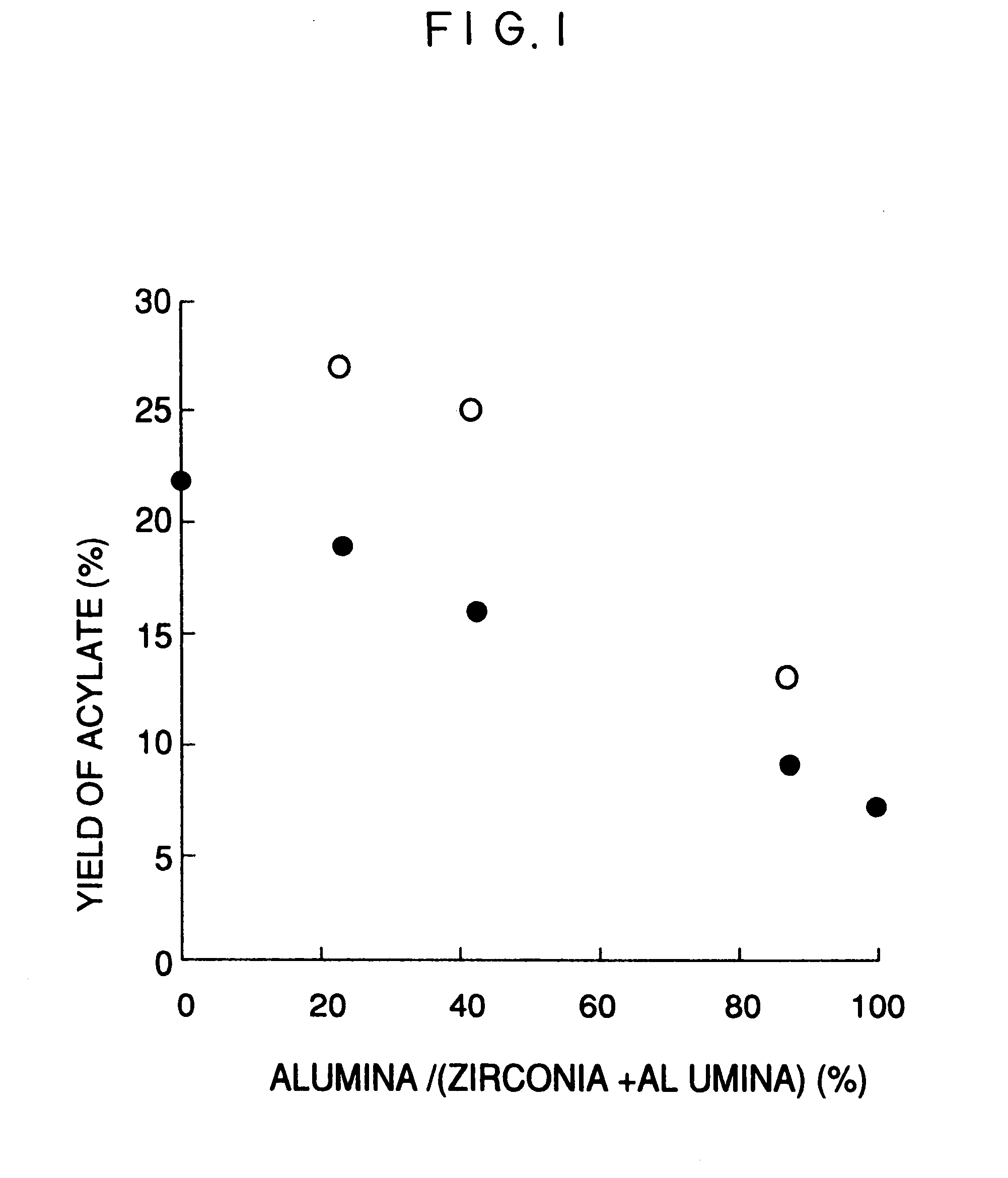Solid acid catalyst and process for preparing the same
a solid acid catalyst and catalyst technology, applied in the field of solid acid catalyst and process for preparing the same, can solve the problems of reporting any process by which a shaped solid acid catalyst is satisfied, and achieve the effects of excellent activity, excellent shapability, and high catalytic activity
- Summary
- Abstract
- Description
- Claims
- Application Information
AI Technical Summary
Benefits of technology
Problems solved by technology
Method used
Image
Examples
example 1
Preparation of Catalyst A
Commercially available zirconium oxychloride (1 kg) was dissolved in 20 liter of distilled water, and 28 wt. % aqueous ammonia was added to the obtained solution under stirring at room temperature to adjust the pH to 8. The formed precipitate of hydrated zirconia was recovered by filtration, washed with distilled water, and dried to give dry hydrated zirconia having a mean particle size of 1.2 .mu.m. Three hundred grams of commercially available powdery hydrated alumina (pseudoboehmite) having a mean particle size of 10 .mu.m was added to 300 g of the above dry hydrated zirconia, followed by the addition of 115 g of ammonium sulfate. The obtained mixture was kneaded in a kneader equipped with agitating blades for 2 hours, while water was added thereto. The kneaded mixture was extruded from an extruder through a circular orifice 1.6 mm in diameter, dried, and calcined at 650.degree. C. for 3 hours to give a sulfated zirconia / alumina catalyst (catalyst A). Thi...
example 2
Preparation of Catalyst B
Commercially available powdery hydrated alumina (pseudoboehmite, 150 g) was added to 450 g of a dry hydrated zirconia powder prepared by the same process as that of Example 1, followed by the addition of 115 g of ammonium sulfate. The obtained mixture was kneaded in a kneader equipped with agitating blades for 2 hours, while water was added thereto. The kneaded mixture was extruded from an extruder through a circular orifice 1.6 mm in diameter, dried, and calcined at 650.degree. C. for 3 hours to give a sulfated zirconia / alumina catalyst (catalyst B). This catalyst had a specific surface area of 205 m.sup.2 / g, and the total content of zirconia and alumina in the catalyst was 87.6%, with the proportion of alumina being 22.9% based on the sum total of zirconia and alumina. Further, the zirconia contained in the catalyst took a tetragonal form and no monoclinic crystal was found. Furthermore, the catalyst had a cylindrical shape having a mean diameter of 1.35 ...
example 3
Preparation of Catalyst C
Commercially available powdery hydrated alumina (pseudoboehmite, 540 g) was added to 60 g of a dry hydrated zirconia powder prepared by the same process as that of Example 1, followed by the addition of 115 g of ammonium sulfate. The obtained mixture was kneaded in a kneader equipped with agitating blades for 2 hours, while water was added thereto. The kneaded mixture was extruded from an extruder through a circular orifice 1.6 mm in diameter, dried, and calcined at 650.degree. C. for 3 hours to give a sulfated zirconia / alumina catalyst (catalyst C). This catalyst had a specific surface area of 280 m.sup.2 / g, and the total content of zirconia and alumina in the catalyst was 85.4%, with the proportion of alumina being 87.6% based on the sum total of zirconia and alumina. Further, the zirconia contained in the catalyst took a tetragonal form and no monoclinic crystals were found. Furthermore, the catalyst had a cylindrical shape having a mean diameter of 1.24...
PUM
| Property | Measurement | Unit |
|---|---|---|
| 2θ | aaaaa | aaaaa |
| 2θ | aaaaa | aaaaa |
| specific surface area | aaaaa | aaaaa |
Abstract
Description
Claims
Application Information
 Login to View More
Login to View More - R&D
- Intellectual Property
- Life Sciences
- Materials
- Tech Scout
- Unparalleled Data Quality
- Higher Quality Content
- 60% Fewer Hallucinations
Browse by: Latest US Patents, China's latest patents, Technical Efficacy Thesaurus, Application Domain, Technology Topic, Popular Technical Reports.
© 2025 PatSnap. All rights reserved.Legal|Privacy policy|Modern Slavery Act Transparency Statement|Sitemap|About US| Contact US: help@patsnap.com

